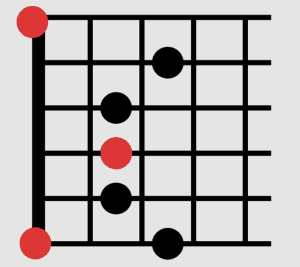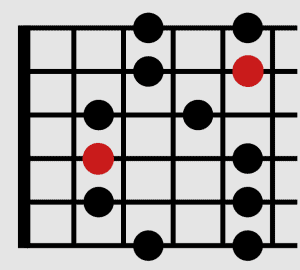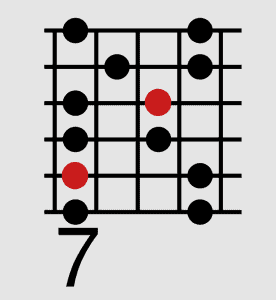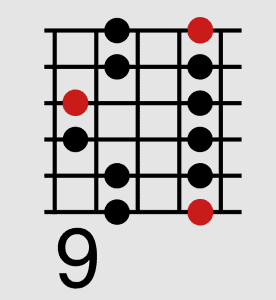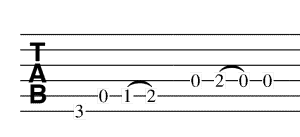The E minor pentatonic scale, like all the other pentatonic scales, is very versatile. It’s very common in blues music, but you’ll find it in just about any genre. The word pentatonic, denotes five notes. That’s all a pentatonic scale is. You may be wondering how a scale with only five notes can be that great. Wouldn’t it get boring?
Nope. There are five different patterns that you can play. These patterns are quite easy to learn, and you can get creative by linking different patterns for a bigger range of higher notes and lower notes in your solos.
Practicing this will help you to get to know the notes on the neck of the guitar, since it’s important to know where the root note is. You’ll also develop more fluidity as you get better at it, and soon you’ll be comfortable playing all over the neck.
Another cool thing about the minor pentatonic scale is that you can play it over major chords too, as long as none of the notes clash and cause dissonance. This makes it an easy way to start soloing, even over major keys, provided they gel together. We’ll get into all that as we go along.
Contents
The Five E Minor Pentatonic Scales
Here are the tabs and the diagrams as you would play them on the neck of the guitar. The root, E, is marked in red in the diagrams. You play the notes using your index and middle fingers or, in the case where the notes span four frets, your pinky. Get to know these shapes well. With practice, you’ll improve your speed and dexterity.
E Minor Pentatonic Pattern 1
Note that this pattern can be played in fret 12 too. Just substitute the 0s with 12s, the 3s with 15s, and the 2s with 14s.
E Minor Pentatonic Scale Pattern 1
E Minor Pentatonic Scale Pattern 1.2
E Minor Pentatonic Pattern 2
E Minor Pentatonic Scale Pattern 2
E Minor Pentatonic Scale Pattern 2.2
E Minor Pentatonic Pattern 3
E Minor Pentatonic Scale Pattern 3
E Minor Pentatonic Scale Pattern 3.2
E Minor Pentatonic Pattern 4
E Minor Pentatonic Scale Pattern 4
E Minor Pentatonic Scale Pattern 4.2
E Minor Pentatonic Pattern 5
E Minor Pentatonic Scale Pattern 5
E Minor Pentatonic Scale Pattern 5.2
How to Use the E Minor Pentatonic Scale to Solo
It can be a little confusing when you think of going from playing the scale to actually soloing, especially since there’s only five notes. But really it’s as simple as letting your creativity run free.
Typically, I’ll use a backing track and let my creative juices flow.
Which Keys to Play the E Minor Pentatonic Scale Over
The five notes in the E minor pentatonic scale are: E G A B D. These notes are all present in the natural E minor scale. But because you aren’t using all the notes from the scale, just these five, you can play this scale over major keys as well as minor keys.
You can play over the following keys:
- E minor
- E major for a bluesy sound (but watch the G as E major has a G#)
- G major (it’s the relative major of E minor as per the Circle of Fifths)
- C Major
- A minor
You need to keep the chord progressions in mind. For example, in G major, you may want to avoid playing the A over a G chord. The same goes for playing a D over the C chord. Or if you’re soloing over the key of E major, if the chord progression uses a G# minor, you’ll want to avoid the G note, and the D. Playing these notes together results in a dissonant sound.
If you want to introduce some tension by including dissonant notes, bend the notes until they go up a whole or semitone as needed.
Techniques that Make Your Solos Sound Great
You don’t need to use these effects on every note, although there are some techniques where you can use them on at least most of the notes. But you can create cool solos using these techniques as accents to spice up your solos.
Pull-Offs
This is where you simply pull your finger off the string to play two notes. They’re often combined with hammer-ons. You don’t pull hard sideways, just slightly to get it to sound. You may need more effort on an acoustic guitar than an electric if you’re only using pull-offs and hammer-ons to play notes. Pull offs are pretty common and can help you to play faster as you often need to do in really fast metal licks.
For example, position your index finger on the high E string (string 1), fifth fret, and your ring finger on the high E string, seventh fret. Pluck the string with your finger or use a pick and then pull off your ring finger. At this stage you don’t even need to pull slightly sideways, you can just lift your finger.
Hammer-Ons
Hammer-ons are where you use place your finger/s a little more forcefully to produce a note without picking or plucking the string. This technique is common during strumming chords to add that extra little something, and it will help your solos too. As with pull offs, when used in conjunction with them, you can often play notes faster than you could perhaps pick them.
You can try it out using the exercise I gave you for the pull off, but instead, pick the note the high E string, fifth fret and then hammer on with your ring finger onto the seventh fret on the same string.
Bending
Bending is a great technique to introduce into your solos when you’re ready, along with vibrato to really make your guitar sing. You can use your other fingers to help you bend the string if it doesn’t interfere with the note you need to bend and you don’t need them to do any other things while you bend the note.
If you struggle to bend the strings, even after much practice by which your fingers should strengthen, you may need a lower gauge of strings.
Vibrato
You can produce vibrato with a whammy bar or a vibrato pedal, but most people just use their fingers by quickly wiggling their fingers or using their wrists to push or pull the strings. You don’t need to bend the string very far, just enough to get a vibrato effect.
Double Stopping
Double stopping is the technique of playing two notes at once. This creates harmonies that give a little complexity to solos in a beautiful way. Heck, throw in a power chord or two as well, it sounds great!
Use Varying Note Lengths
While a bunch of really fast triplets or quickly shredding a few notes on the electric sounds great over rock and metal music, this isn’t all there is to solos. You’ll hear that in most styles of rock and metal that there is variation in the note lengths.
This is true of a variety of genres. After all, a solo is a melody. A catchy, memorable melody that adds that little something to songs.
When you start practicing by using the scale, you won’t believe what a difference it makes to play those ascending or descending notes in varying lengths. While you do want to branch out to varying the actual notes so that you aren’t always just going up or down, you can learn to phrase your ascending and descending notes in a way that sounds awesome.
So do some long notes, do some short and some medium length notes too. But be sure to make it sound musical.
Use Various Patterns
Linking to the other patterns will give you more variety in terms of pitch and tone. Get creative and see what you like. It can be difficult at first to get the hang of traveling all over the neck of the guitar, but with practice you’ll be moving around like a pro.
Root Notes
Whatever key you’re in, play the root note during your solos, this will make the solo feel like it’s home. E would be the root for E minor, G for G major, A for A minor, etc.
If you’re playing over a chord progression, find out what chords you’re playing over. Then hit the root note of each chord when you play over it, provided, of course, that the root note is in the E minor pentatonic scale. This can just help everything feel like it’s flowing well. But if it’s not possible, and the scale fits the key you’re playing over, you’re going to be able to get some nice harmonies in there too.
Timing is Everything
Not trying to make a pun here, but you if you play hammer-ons, pull-offs, vary your note lengths, and throw in a few bends and some vibrato, but you’re doing it all out of rhythm, it just sounds sloppy. Let the drums be your guide, or tap along to the rhythm guitar or piano if there are no drums.
But if you aren’t using a backing track or playing with other people, consider getting a metronome like Sound Brenner which is available on Android and Apple. This is going to really help you as you speed up your solos if that’s your thing too. Because again, you can shred as fast as you want, but if the notes are inconsistent, you’ll end up sounding sloppy instead of awesome.
Jamming to a Backing Track
If you don’t have a friend to play with or a loop pedal at your disposal, a backing track is one of the best tools you can use to have fun while practicing your scales and creating solos out of them. Use the tips above to craft your solos. And remember, don’t stress if you hit a wrong note, just learn from it and carry of jamming.
Here are a few backing tracks in E minor that you can try:
For those of you who want a slow rock ballad:
Feeling soulful and groovy? Here you go:
Groovy but chilled:
Postrock for a heavier feel:
You can find backing tracks to your liking and in the key you prefer on YouTube, Spotify, and even some websites offer backing tracks for free or to buy.
Popular E Minor Pentatonic Guitar Licks
If you need some inspiration to start or get out of the rut of doing the same things over and over, playing licks from songs you enjoy or trying these out if they’re new to you, could be just what you need.
E Minor Pentatonic Rock and Metal Lick
E Minor Pentatonic Rock Lick
This lick looks boring, but it’s meant to be played really fast. The notes between the slurs are to be pulled off and hammered on. So the V means to pick upward and that is where you’ll start. While that might seem a little weird, but it’s meant to help with speed and is a technique that a lot of people use when having to play so fast.
How to do it:
- Start with an upward pick in the 12th fret as shown, using your index finger to fret it
- Hammer on the 15th fret with your ring finger
- Then pull off
- Ring finger to the 15th fret on the 2nd string (B string), downward pick (that’s what the bracket means)
- Repeat as shown and then finish with the 12th fret, high E string, and throw in some vibrato as shown by the squiggly line
Start slowly. This may seem tedious, but remember, you want to sound awesome, not sloppy. Each note is of equal value, so they are all the same length. Aim for consistency. To count it, use the 16th note method, 1 e and a 2 e and a 3 e and a 4 e and a. Speed up slowly, only going as fast as you can play it consistently.
E Minor Pentatonic Country Lick
E Minor Pentatonic Country Lick
This lick goes well over country music. You don’t need to be Speedy Gonzalez with this one. It’s a pretty simple lick with a few pull-offs to make it sound a little more interesting.
How to do it:
- You can start with a downward pick on this one
- Upward pick the open A string (5th string)
- Downward pick the 1st fret on the A string
- Hammer-on the 2nd fret
- Upward pick the open D string (4th string)
- Downward pick the 2nd fret
- Pull-off to the open string
- Upward pick the open D string
You can play around with this one according to the backing track or music you’re playing with. It’s pretty short, so don’t be afraid to add to it.
The E Minor Pentatonic Blues Lick
E Minor Pentatonic Blues Lick
This lick is good over blues songs. In this one you get to try out some bends. You don’t need to play this very fast, just match the tempo of the music you’re playing to.
How to do it:
- Downward pick the 9th fret on the G string (3rd string)
- Upward pick the 8th fret on the B string (2nd string)
- Downward pick the 10th fret on the B string
- Upward pick the 10th fret on the high E string (1st string) and bend the note up a whole tone (or the equivalent of two frets) and give it some vibrato, be dramatic
- Drop the bend and staying in the 10th fret, downward pick that same string and bend the note up a whole step again, you can be less dramatic here
- Drop the bend and then staying in the 10th fret, same string, upward pick the note
- Pull-off to the 7th fret
- Downward pick fret 10
- Upward pick the same string, 7th fret and bend the note until it’s slightly out of tune.
You can find more guitar licks to practice and give you inspiration.
Conclusion
So now you’ve seen how you can do some cool things with the minor pentatonic scale. With E minor you’re in luck in that it covers one of the most popular guitar keys, G. So you’ll find plenty of songs to play it over. And although it seems so simplistic, you can take it where your imagination and creativity leads.
Play around with different speeds and techniques and see what you can come up with. Whether you play acoustic or electric, you can play some really awesome solos or incorporate licks into your rhythm playing for a little flare.
Practice slowly in the beginning. Proper practice makes perfect, if you practice in a sloppy manner, that is what you’ll sound like. Practice everything properly, and with time, you’ll sound like a pro. Above all just have fun. Music is expression. Make that guitar sing.

Cheanné Lombard lives in the home of one of the new Seven World Wonders, Cape Town, South Africa. She can’t go a day without listening to or making music.
Her love of music started when her grandparents gave her a guitar. It was a smaller version of the full-sized guitars fit for her little hands. Later came a keyboard and a few years after that, a beautiful dreadnought guitar and a violin too. While she is self-taught when it comes to the guitar, she had piano lessons as a child and is now taking violin lessons as an adult.
She has been playing guitar for over 15 years and enjoys a good jam session with her husband, also an avid guitarist. In fact, the way he played those jazzy, bluesy numbers that kindled the fire in her punk rock heart. Now she explores a variety of genres and plays in the church worship group too and with whoever else is up for a jam session.

